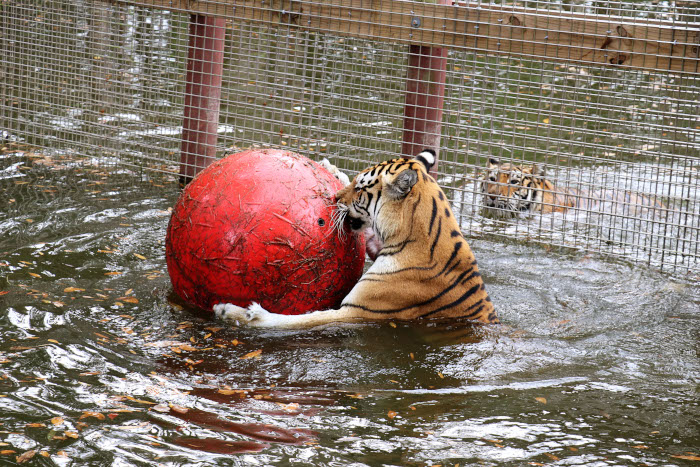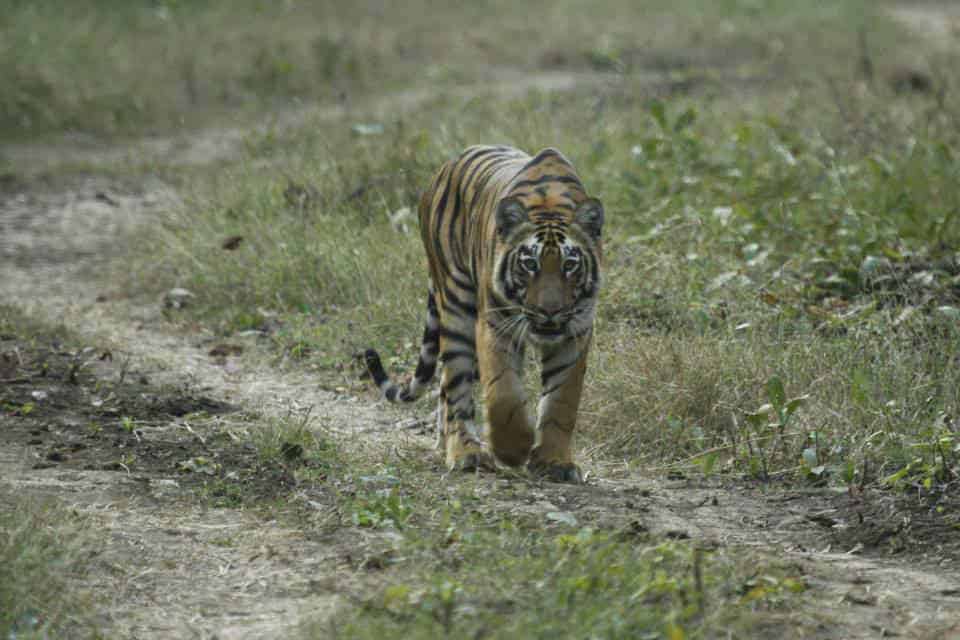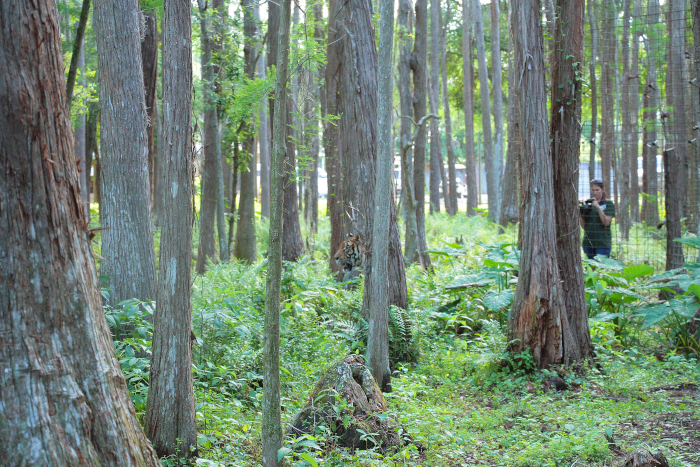The popularity of Tiger King has brought A LOT of attention to zoos and sanctuaries. While the docuseries was entertaining, it didn’t really cover the true differences between these types of places. Unfortunately, there is a lot of misinformation spreading.
One of the biggest questions people ask me, a wildlife biologist, about Tiger King is: Isn’t Carole’s Big Cat Rescue just as bad as the zoos?

Before I specifically address Big Cat Rescue, first let’s talk about what a wildlife sanctuary actually is and how it differs from a zoo.
In short, zoos are collections of animals for public display. People originally created zoos for entertainment, but ethical zoos now play a strong role in conservation and education. In my last post, I talked extensively about how zoos vary dramatically in their contributions to conservation, education, and animal welfare standards, and how you can tell the difference between ethical zoos and ones that are in it purely for profit.
Originally, people captured animals from the wild to put them in zoos. Over time, scientists and the public decided this was unethical and a threat to conservation. Instead, most zoos now captive breed animals to maintain their captive populations (However this mostly applies to developed countries and worldwide there are facilities that still capture animals from the wild. In Thailand, the tourism industry is a threat to Asian elephants).
Captive breeding is the key difference between zoos and sanctuaries. There are good zoos and bad zoos (and you’ll soon find, good sanctuaries and bad sanctuaries).
What is a Wildlife Sanctuary?
A wildlife sanctuary describes a place specifically built for captive animals that become unwanted for a variety of reasons.
As you saw from Tiger King, many private individuals own tigers in the United States alone. Estimates claim there are more in Texas alone than even in the wild!
People purchase tigers when they are small cubs and easy to handle. Then when they become full grown tigers, they realize they can’t take care of them any more. Tigers need a lot of space and are expensive.
Animals go to a wildlife sanctuary when roadside zoos or circuses run out of business or can no longer take care of their animals for financial reasons. Animal circuses are becoming less and less popular over time especially in more developed countries. Some cities and even countries banned the use of animals in circuses.
Wildlife sanctuaries provide care to neglected and abused captive animals for the rest of their lives. A wildlife sanctuary DOES NOT BREED or sell animals. The animals that come to a wildlife sanctuary stay there until they die of natural causes.
One question I've gotten a lot is: What's the difference between Joe Exotic's zoo and Big Cat Rescue? A real sanctuary is a rescue organization. It doesn't breed or allow hands-on interactions, and it doesn't make animals perform or entertain.
— National Geographic (@NatGeo) April 2, 2020
Theoretically, wildlife sanctuaries should exist purely out of necessity. A true wildlife sanctuary will hope that one day there will be no need for such sanctuaries. They will hope that individuals will no longer be able to easily purchase and own large exotic animals like tigers. Some sanctuaries, like Carole’s Big Cat Rescue, even work to change these laws.
Why Do We Need Wildlife Sanctuaries?
Wildlife with Nowhere to Go
We need wildlife sanctuaries because without them, we would have to euthanize beautiful and otherwise healthy exotic animals. After Mexico banned animal circuses, people abandoned their expensive exotic animals.
Many of these animals are threatened or endangered in the wild so it also seems wrong to put them down with so few individuals in the wild. Although some people do argue that it is more humane to euthanize the animals than for them to be in captivity at all even in a wildlife sanctuary.
Why Can’t the Animals Go to Ethical Zoos?
Why can’t these animals go to ethical zoos? I recently did an Instagram live with Taylor Francis who used to work at a wildlife sanctuary. She said a lot of zoos do not want former pets and animals from roadside zoos because they no longer looked or acted like wild animals.
As you saw in Tiger King, breeders tame animals for pets or public interaction by removing the baby immediately upon birth. Breeders want the babies to bond with them and other humans instead of the animal’s mother.
Many exotic animal owners anthropomorphize their animals (make them act more human-like). They dress chimpanzees up in human clothing. Owners alter their animals physically. Taylor’s sanctuary accepted a bobcat whose teeth were shaven down to protect the owner from biting them. Zoos do not want unrealistic portrays of wild animals in their exhibits because one of their major objectives is to educate the public on wild animals.
Finally, ethical zoos will eventually run out of space. Places that allow cub petting breed their animals all year long to ensure there are always babies for tourists to pet. No zoo can house an endless supply of animals especially large ones like lions and tigers.
Can You Release the Animals to the Wild?
Captive Born Animals: No
Hand-raised animals cannot survive in the wild. Many animals, especially mammals, learn how to hunt and forage for food, protect themselves from predators, and interact with other animals from their mothers. Animals raised by humans will not have these skills and will therefore not survive.
Scientists plan reintroduction programs for captive-bred species VERY carefully. They intentionally captive breed animals to be released into the wild. Therefore they minimize human contact with these animals and design enclosures to ensure their survive in the wild.
Many threatened and endangered species do not have habitat to go to in the wild. Habitat loss is the biggest cause of species extinctions across the globe. Scientists have to plan exactly where they will release animals into the wild. If you release a tiger into a village in India, it will not survive.
A big challenge for tiger conservation in India is diminishing habitat. In fact, India successfully increased its tiger population in recent years. Now, the biggest challenge is identifying corridors for tigers to move through protected areas safely and easing human-tiger conflict. Many of the protected areas are at capacity with tigers. Tigers are territorial and will not necessarily let new individuals use their home range.

Most of the species at wildlife sanctuaries in the United States are from another continent. Transporting animals across international waters requires intense logistics, funding, and it would be extremely stressful for the animals.
Wild Born Animals: Rarely
The exception to this rule is when the sanctuaries obtain animals born in the wild and the sanctuary is in or close to the animals’ native range. For example, Lola Ya Bonobo is a bonobo sanctuary, rehabilitation, and release center in the Democratic Republic of Congo (DRC).
In DRC, poachers kill bonobos for bushmeat, but keep the babies alive to sell them for the illegal pet market. The babies can be tamed, but older individuals cannot be. Lola Ya Bonobo has successfully rehabilitated orphans and reintroduced them into the wild directly helping the conservation of the wild species.
If you look in the skies of Columbia, Missouri you might see a turkey vulture named after me. My undergraduate students volunteers at our lab at the University of Missouri also worked at Raptor Rehabilitation center. I joked with them that I wanted an owl named after me. The raptor center rarely got owls, but they did get a turkey vulture that was hit by a car, which they named after me. The veterinarian students rehabilitated the turkey vulture and it fully recovered! Turkey vultures rarely recover from vehicle collisions so this was especially exciting. Stephanie the turkey vulture now flies over the skies of Columbia, Missouri and I was able to go to her release into the wild.
However, scientists do not have a good sense of the survival rate of rescued/rehabilitated animals’ after release. The injuries and trauma that brought the animal in to the sanctuary may affect their overall survival. It’s possible that sanctuaries spend a lot of money rehabilitating these animals and then they just die shortly after in the wild. It might be more effective to fund conservation projects on wild animals instead.
Education
Sanctuaries educate the public in two ways. First, like zoos, animals in sanctuaries can act as ambassador animals. Sanctuaries provide educational content through their websites and social media pages, and some sanctuaries provide tours to the public (more on that later).
DRC is the only country with bonobos and bonobos are threatened by severe poaching and deforestation. Lola Ya Bonobo offers the local community the extremely rare opportunity to see a bonobo at all. Most people don’t have television or the ability to travel to see them (it is expensive and dangerous). Lola Ya Bonobo allows people to fall in love with bonobos and to educate them about their threats in DRC. This education is a KEY component to ensuring bonobos are conserved in DRC.
Sanctuaries in the United States and in other countries outside of the animals’ native range educate the public on the exotic animal ownership. Lions, tigers, and chimpanzees are large animals that are extremely difficult to provide for. As more people learn about sanctuaries, they will learn that owning an exotic animal is not a good idea and spread the message.
How to Tell a Real Wildlife Sanctuary from a Sham
Seeing animals in sanctuaries tugs at your heartstrings. You feel sorry for the animals. A lot of people are willing to give donations. Animal parks and tourist operations have learned this and call their places sanctuaries even though none of the animals are unwanted or orphaned.
Nowadays you have to be really careful when visiting places called sanctuaries. It is very hard to tell the difference between ones that are saving and taking great care of their animals and ones that are doing it just for profit.
Here are some guidelines to help you:
The Animals Do Not Perform Tricks
The whole premise of a wildlife sanctuary is to retire animals from performing for human entertainment. They view the animals as “retired” from performing, whether it is in a circus doing tricks, as someone’s personal pet, or in a small cage on display in a roadside zoo. Sanctuaries exist to allow the animal to live out the rest of its life without suffering any more abuse. You cannot train animals to do the types of tricks in circuses without suffering from abuse.
You Can’t Touch the Animals or Touching is Limited
Given that all animals that end up at a wildlife sanctuary have suffered from abuse (either physical or negligence), true sanctuaries alleviate animal suffering as much as possible.
The Elephant Sanctuary in Tennessee does not even let the public see the elephants because they want the elephants completely retired from any form of entertainment.
There is NOT an Endless Supply of Babies
Breeding is a key difference between the Big Cat Rescue and the other zoos featured in the Tiger King. The zoos featured purposely bred big cats so they could make money. Cubs are the main money-maker because they are insanely cute and people pay a lot of money to take their photo with them. In the Tiger King, one person said you can’t put a price on getting your photo taken with a tiger cub.
These zoos do not keep all of the cubs they breed. It is impossible. They sell them to private individuals, other roadside zoos, canned hunts, or put them down themselves. Joe Exotic killed at least five tigers which led to his jail sentence.
There are exceptions to this rule which makes navigating between good and bad sanctuaries so difficult. Some places (not really called wildlife sanctuaries though) take in orphaned animals and release them back into to the wild.
When I was in Sri Lanka many years ago, we were excited to be scheduled to visit an orphan baby elephant sanctuary ….until we learned that to stay in business, these places had to keep producing "orphan" baby elephants. We cancelled our visit. 🙁
— Kimberly Moynahan 🌎🇺🇸🇨🇦 (@Kim_Moynahan) April 1, 2020
For example, the Sheldrick Wildlife Trust (SWT) rescues orphaned elephants and rhinos. Poachers kill elephants for their ivory and rhinos for their horns often leaving calves motherless. SWT acquires and takes care of these orphans until they are old enough to be released to the wild, which can be up to 15 years for elephants. Elephants and rhinos are threatened and endangered species in Africa and this program directly aids in their conservation.
The Animals are Behind Barriers
All exotic animals are innately wild and therefore dangerous. Although they are tame, they are not domesticated species, which have co-evolved to live with humans for tens of thousands of years. Because they are wild, you truly never know what they will do.
Again, being a sanctuary, these species should be retired from being close to people which is stressful for animals. When there are no cages or the animals are forced to sit there and pose with people, this is a limitation on how they can live out their lives.

The Animals Have Proper Have Shade, Water, and Food
This is a must for all animals period. I’m listening to Wonderly’s Exotic Joe podcast and so far they’ve mentioned two animals (a liger and a bear) at Joe’s Greater Wynnewood Exotic Animal Park that died from dehydration. Joe also kept a cage of stray domestic cats starved, dehydrated, and in the sun to “make them sluggish” so he could feed them to the snakes.
Additionally, some of these animals in exotic animal parks are not adapted to live where they are purchased. In the very first episode of the Netflix series Tiger King, you see a snow leopard someone purchased in the backseat of someone’s car. They mention it is 100 degrees in Florida. Snow leopard are called snow leopards for a reason; they live in very cold areas. Putting a house cat in the back of a hot car is not humane, let alone a snow leopard.
No Red Flags on the Internet
Always Google and search for the wildlife sanctuary on TripAdvisor before you go. On TripAdvisor, read the reviewer’s comments and look at the photos that they take. Photos on the sanctuary’s website will be the best of the best or old, while the photos that tourists take reflect what is actually going on.
Make sure to visit the sanctuary’s website. Remember sanctuaries take animals in for the rest of their lives. The sanctuary should have information posted about most of the individual animals that live there and their histories (where they came from and how the sanctuary got them).
Don’t trust what people tell you in person because they could just be making it up on the spot. It was very clear listening to the Wondery podcast on this series that Joe was a pathological liar and even faked cancer at one point.
They Prioritize Animals Over People
Overall, you want to see if the sanctuary is focused on animals or people. If it’s the later, it is likely more for entertainment and money. If all of the photos on the sanctuary have people in them, this suggests the sanctuary favors tourism and therefore profits before animal welfare.
On the other hand, if the photos are mostly of the animals, this shows the sanctuary prioritizes the animals’ wellbeing.
They are a Non-Profit
A true wildlife sanctuary will be a non-profit. They will not be a sanctuary to make money. Of course they will have to fundraise to ensure the animals are cared for and they can grow their facilities, but the founders are not in it to get rich. As a non-profit, they must be transparent about how they spend your money and their expenses.
Some Wildlife Sanctuaries that are Doing it Right
The Elephant Sanctuary in Tennessee
This wildlife sanctuary takes in former performing elephants from circuses and zoos. It is a HUGE sanctuary with a lot of wild space for the elephants to roam in.
A really cool story about the Elephant Sanctuary is that they took in two elephants that knew each other from performing years and years ago. The sanctuary staff did not know this and couldn’t understand why they were acting so unusual when they were put next to each other in holding facilities. Watch their reactions as they remember each other.
Lola Ya Bonobo
As mentioned before, this sanctuary is doing it right! The provide essential education to the local community on bonobo conservation, release bonobos to the wild, and provide a lifetime of care. Scientists even conduct extremely important behavioral research on the bonobos there.
Save the Chimps
Save the Chimps is home to over 240 chimpanzees rescued from research laboratories, the entertainment industry, and the pet trade. These chimpanzee live across over 12 islands on 150 acres in Florida.
Did I miss a sanctuary that you think is doing it right? Let me know in the comments below.
Love this post? Share it with friends!



